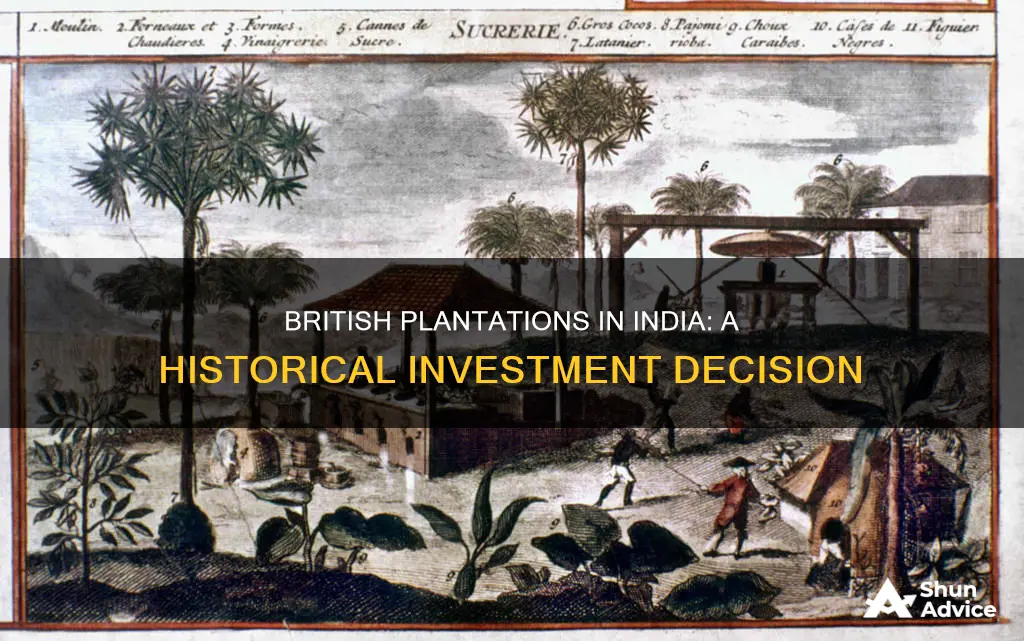
The British invested in plantations in India for several reasons. Firstly, there was an increase in demand for plantation products like tea, coffee, and indigo, which could not be grown in Britain. Secondly, plantations often occupied large areas of land and could provide a significant number of jobs for people in India. Additionally, the British East India Company played a crucial role in establishing British control over Indian trade and resources, including the production of cotton textiles, silk, spices, and rice. The company's policies and the subsequent British rule had a significant impact on India's economy and society, with long-lasting effects even after independence.
What You'll Learn

To meet rising demands for tea, coffee, and indigo crops
Tea, coffee, and indigo crops were in high demand in Britain during the 18th and 19th centuries. The British introduced plantation industries in India to meet this demand.
Tea became one of the British Empire's most prized resources in the 18th century. In 1784, the Tea and Windows Act was enacted, which reduced the tax on tea from 119% to 12.5%. This caused tea consumption to explode in Britain. By the end of the 18th century, even very poor peasants were consuming tea twice a day.
Coffee also became a popular drink in Britain during this period. The first London coffee house opened in 1652, serving coffee to merchants in the city's commercial and financial centre. Coffee houses became spaces for men to meet, relax, and discuss business, news, politics, and ideas. They played a key role in the spread of modern democracy, the Enlightenment, and the birth of periodical literature.
The demand for indigo in Britain increased due to its use as a cloth dye. The massive expansion of cotton production and industrialization in Britain led to a surge in demand for cloth dyes. At the same time, the supply of indigo to Britain from America and the West Indies collapsed. As a result, Britain turned to India as a new source of indigo, and by 1810, 95% of the indigo imported into Britain was from India.
Saving Precedes Investing: The Foundation of Financial Planning
You may want to see also

To provide jobs to a lot of people
The British introduced plantation industries in India, in part, because of the large number of jobs they could provide. Plantations were a staple form of agricultural production throughout the history of the British Empire. They were established to provide economies of scale and make the production of goods viable.
Plantations required a significant amount of capital to start, including the purchase of housing, seeds, and land. They also required a large number of workers. In the New World, the labour shortage was initially solved by the importation of slaves. However, after the slave trade was abolished in 1807 and slavery in 1833, plantation owners turned to the system of indentured labour. This system, in which labourers agreed to work for several years in exchange for passage and a small wage, created massive internal migration within the Empire, with workers from India and China being moved between colonies.
In India, the British East India Company established plantations to grow cash crops such as tea, coffee, indigo, and jute. These plantations provided jobs for a lot of people, including agricultural workers who were often forced to grow cash crops instead of food crops. While the planters and British traders made considerable profits, the workers were poorly compensated and forced into debt, sometimes even starvation.
The introduction of plantation industries in India also served to meet the rising demand for coffee, tea, and indigo crops. The British Empire presided over mass migrations of seeds and plants throughout its lands in pursuit of profit. In the case of India, the British invested in plantations to take advantage of the large areas of land available for cultivation and the increase in demand for plantation products.
Investing vs. Saving: What's the Real Difference?
You may want to see also

To benefit from the large areas occupied by plantations
The British introduced plantation industries in India to benefit from the large areas occupied by plantations and the subsequent economic advantages.
Firstly, the vast areas of land occupied by plantations could provide jobs for a lot of people. The introduction of plantation industries also served to meet the rising demand for crops such as coffee, tea, and indigo. Plantation agriculture involves cultivating a single crop, like tea, commercially on a large area of land.
Secondly, the British benefitted from the large areas occupied by plantations by forcing Indian producers to export their goods directly to other countries while ensuring that the payments for those goods ended up in London. This was done through the use of Council Bills, a unique paper currency issued only by the British Crown. Traders had to pay London in gold to get these bills, which they then used to pay Indian producers. When Indians cashed the bills, they were paid in rupees from tax revenues, which had been collected from them. This meant that Indians were not actually paid for their goods, as the money used to "pay" them had originally been taken from them in the form of taxes.
Thirdly, the British benefitted from the large areas of land occupied by plantations by implementing policies that favoured British economic interests at the expense of Indian producers. For example, the British enforced high tariffs and duties on textiles produced in India, making them impractical for export. At the same time, raw cotton was imported from India to British factories without any tariffs. The factories then manufactured textiles from the Indian cotton and sold them back to the Indian market. This gave Britain a monopoly over India's large market and cotton resources.
Finally, the large areas of land occupied by British plantations in India contributed to the deindustrialization of India. The British introduced policies that disrupted industrial production and forced Indian workers into agriculture at unsustainable levels. This drove down rural wages and ultimately contributed to poverty in rural India.
Sustainable Investing: Managing Environmental Risks and Creating Value
You may want to see also

To increase exports from Britain to India
The British introduced plantation industries in India to increase exports from Britain to India.
The British East India Company, formed in 1599, was initially focused on trade with Asian nations in the south and southeast. However, the company soon began to meddle in Indian politics, and its victory over the Mughal Empire in 1764 marked the beginning of India's deindustrialization. The company, and later the British, implemented protectionist policies that restricted Indian textiles from being sold in Britain. Tariffs and duties on Indian textiles reached 70-80%, making them impractical for export.
At the same time, the British forced open the large Indian market to British goods, which could be sold duty-free, giving them a monopoly over India's market and cotton resources. The East India Company used a portion of the tax revenues collected in India to fund the purchase of Indian goods for British use, effectively "buying" from peasants and weavers using money that had just been taken from them. This system of exploitation allowed Britain to finance a flow of imports from Europe, including strategic materials essential to its industrialization.
The British also enforced policies that made it mandatory for landowners in India to grow certain crops, such as indigo, on a portion of their land. These crops were then exported to Europe and Britain, where they commanded high prices due to their quality and potency. The profits from these exports further enriched British traders and contributed to the development of Britain.
The establishment of plantations in India was part of a broader strategy to increase exports from Britain to India, exploiting the country's resources and markets to fuel Britain's industrialization and economic growth.
Indian Rupee: Worth Investing in the Long Term?
You may want to see also

To take advantage of India's natural resources
The British introduced plantation industries in India to take advantage of the country's natural resources.
India had a rich history spanning 4000 years, with a recorded history going back to the Indus Valley Civilisation in Harappa and Mohenjo-daro. In the 17th century, India was a relatively urbanised and commercialised nation with a large export trade. It was the world's main producer of cotton textiles and traded these, as well as silk, spices, and rice, with Britain and other European countries via the East India Company.
The British landed in India in 1608, initially for trade. They traded in spices, silk, cotton, indigo dye, tea, and opium. However, they soon became interested in acquiring territory. The British East India Company, formed in 1599, started to meddle in Indian politics and concentrate the resources of the various provincial kingdoms. The company's power grew until it became a ruling power in the region.
The British introduced plantation industries in India to take advantage of the country's natural resources and meet the rising demand for crops such as tea, coffee, and indigo. These crops could not be grown in Britain, and the large areas occupied by plantations provided jobs for a lot of people.
The British also invested in Indian infrastructure, irrigation, and industry. They increased the area of irrigated land eightfold and improved the village economy. However, they also enforced high tariffs and duties on Indian textiles, making them impractical for export. This deindustrialised India and forced many Indian workers into unsustainable levels of agriculture, driving down rural wages.
The British also intercepted the income from India's exports, which rightfully belonged to Indian producers. They used this windfall to fuel their imperial ventures and expansion of capitalism in Europe and regions of European settlement.
Monitoring Your Investment Portfolio: Strategies for Success
You may want to see also
Frequently asked questions
The British invested in plantations in India to meet the rising demand for crops like tea, coffee, and indigo.
There was a rising demand for these crops in Britain and elsewhere. Tea and coffee, for example, were becoming increasingly popular beverages.
The crops grown in the plantations, such as tea, coffee, and indigo, could not be grown in Britain due to differences in climate and soil conditions.
No, they also grew jute and rubber.
The social and economic impacts of British plantations in India were mixed. On the one hand, plantations provided jobs for a large number of people. On the other hand, workers in the plantations were often poorly compensated, forced into debt, and subjected to harsh and unrelenting working conditions.







